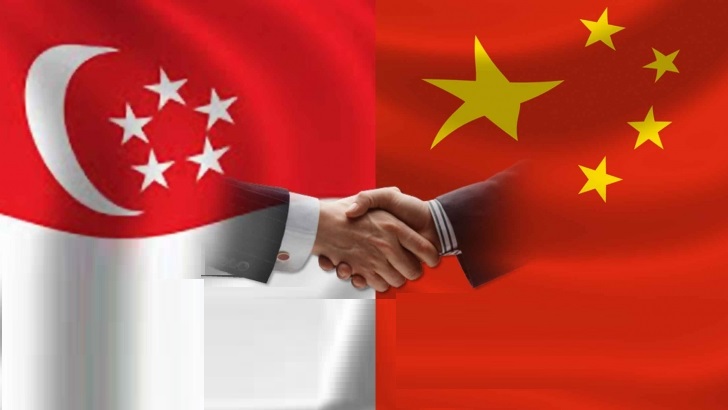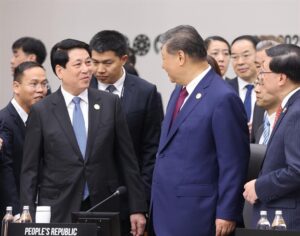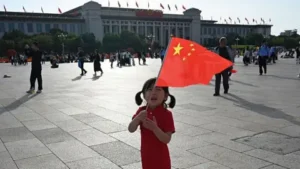China and Singapore Stepping Up Cooperation Under the Framework of Belt and Road Initiative

China’s BRI was launched as a vast development and investment program aiming to create a unified market across continents. The BRI is a win-win initiative, linking up countries around the region in terms of finance, infrastructure projects, and people-to-people connectivity. In the last decade, the BRI expanded to Latin America, Europe, Africa, and Asia with more than 150 participating countries, including Singapore. When China started this initiative, Singapore identified the positive opportunities in the BRI project for both countries, which include reducing trade barriers, strengthening trade links, the emergence of new markets and opportunities, and collaborating in green financing and green technology.
There are constructive bilateral relations between China and Singapore, and they both leverage each other’s strength. Both countries are looking forward to a multilateral trading system to promote the construction of free trade zones and facilitate the liberalization of trade and investment, as trade is the most important engine of economic growth. Singapore is in the position to play a crucial role in the Belt and Road Initiative. It has the potential to be an all-round cooperative partner with China. Moreover, it will provide space for Singapore’s own development and also contribute to regional growth and stability.
High-level delegation tours and agreements
Singapore’s Senior Minister Lee Hsien Loong was amongst the first batch of foreign political leaders to officially visit China to meet the Chinese President Xi Jinping. Both the officials nodded in unison for not only “All-Round High-Quality Future-Oriented Partnership” (AHFP), but also knotted the ties tighter in building an open, peaceful, and inclusive region. As they consider BRI a compass pointing to untapped potential in the fields of trade, investment, the digital economy, and green finance.
In the Second Belt and Road Forum held in 2019, Senior Minister Lee spotlighted four arenas for Singapore’s participation in the BRI: infrastructure connectivity, financial connectivity, third-party collaboration, and professional and legal services.
Infrastructure connectivity
China and Singapore are collaborating to shore up their relations under the umbrella of the Belt and Road Initiative. For this, they have developed a project termed the New International Land-Sea Trade Corridor (ILSTC) under the China-Singapore (Chongqing) Demonstration Initiative. This is the lifeline of commerce for trade and logistics, connecting Western China to 119 countries and regions, including Southeast Asian countries (ASEAN), through this belt road. In China’s 14th Five-Year Plan (a roadmap for development), they plan to build a new corridor to improve trade, logistics, industrial cooperation, and cultural exchanges between Western China and ASEAN. Singapore will play a key role as one of the dual hubs (alongside Chongqing) in this network, strengthening its position as a major logistics hub in the Asia-Pacific region.
Financial Connectivity
The China-Singapore (Chongqing) demonstration initiative on strategic connectivity, CCI, was launched in 2015. This helps to foster a robust financial partnership between China, Chongqing, and Singapore. The project connects Western China to Southeast Asia through four fundamental sectors: Financial Services, Aviation, Transport and Logistics, and Information Technology. By the end of 2023, over 550 projects worth about $56.5 billion were committed, including cross-border financing and investments. In 2023, the CCI Financial Summit saw 90 projects worth RMB 111 billion signed, with 17 agreements between Singaporean and Chongqing companies focusing on areas like FinTech and cross-border financing. Additionally, Singapore and China have strengthened ties through agreements like the China-Singapore Free Trade Agreement Upgrade, which improves market access for Singaporean businesses in China, and partnerships between stock exchanges for ETF products. These efforts highlight the growing financial connectivity and collaboration between the two nations, benefiting businesses and investors in both regions.
Professional and Legal Services
An MOU was signed between the Supreme Court of Singapore and the Supreme People’s Court of the People’s Republic of China in April 2023 to solve international commercial disputes in the context of BRI through a litigation-mediation-litigation (LML) framework. This covers BRI-related international trade and commerce disputes, including infrastructure development and construction works, and the financing of such activities. It also recognizes the increasing complexity of disputes of such nature and seeks cross-border cooperation on dispute management practices (including information on procedural rules and case management practices). This further affirms Singapore’s position as an ideal, neutral party to resolve BRI disputes quickly and effectively and bolsters Singapore’s status as a regional and global dispute resolution hub.
Easy Terms of Financing
The central banks of Singapore provide a facility to China to set the city-state up as a trading hub for the Chinese yuan. This move would allow the Chinese banks to do more business outside the mainland. Singapore is among the very top official markets for the Chinese yuan. Singapore has always been one of the leading offshore markets besides Hong Kong and London. A well-established exchange facility, rules and regulations, and credibility and trust built into the financial system help the businesses to operate in a more cost-effective and budget-friendly manner.
Singapore’s steadfast support for China’s green transition
China, in its second Belt and Road Forum in 2019, outlined a vision of open, green, and clean cooperation. Since it supports the 2030 agenda for sustainable development, its government actively promotes policies like the Singapore Green Plan 2030, Zero Waste Masterplan, and Resource Sustainability Act, aiming for a “City in Nature” with green spaces, renewable energy, and waste reduction by 2030.
In 2015, all 193 United Nations member countries adopted the 2030 Agenda for Sustainable Development Goals together with the Paris Agreement, which was ratified a year later in 2016. It marked a shift to the beginning of a net-zero emissions world. After which China took its commitments seriously, and in 2019 it took steps to green the BRI. Singapore has also embarked on this green journey as a key supporter. Singapore will not be able to stop climate change on her own until all the countries, big and small, join hands and play their part.
In 2021, the Singapore Green Plan 2030 was unveiled. This is a whole-of-nation movement with key focus areas on improving waste management and lowering carbon emissions, along with developing green services and technology. The government has pledged to the net-zero plan for the entire nation, so this can be seen as a very important commitment and action. Singapore’s Green Plan has basically laid out a few important ingredients, including building resilience for climate risk management and also developing financial products and solutions for a more sustainable economy.
Opportunities for Singapore in BRI
As the BRI comes into alignment with the green plan of Singapore, this will represent opportunities for Singaporean companies and their investors. For Singapore firms to do well, they need to figure out what roles and services they can provide that are best suited in this context, such as green technology and green innovations. Singaporean entrepreneurs are already coming up with innovations that are contributing to building a great green China.


